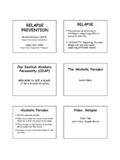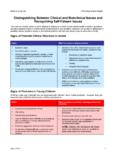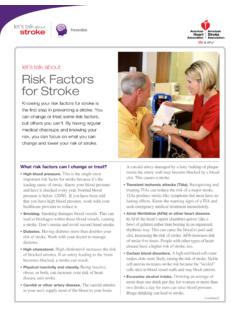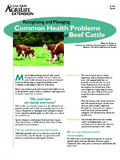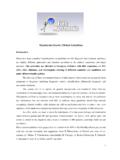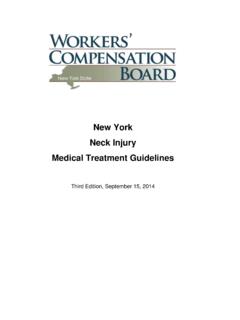Transcription of Recognizing Impairment in the Workplace - - …
1 Recognizing Impairment in the Workplace Developed August 2017, Expires August 2019 Provider Information and Specifics available on our Website Unauthorized Distribution Prohibited 2017 , , , LLC By Wanda Lockwood, RN, BA, MA The purpose of this course is to outline the risk factors, signs, symptoms and interventions associated with Impairment in the Workplace and to meet the Florida CE requirements. Upon completion of this course, the nurse should be able to: Identify 6 types of risk factors. Identify at least 10 behavioral and physical signs of Impairment in the Workplace .
2 Identify at least 10 behavioral and work-related signs of diversion. Discuss the elements of Florida s mandatory reporting laws. Outline the essential steps to making a report or referral. Describe the elements of the Intervention Program for Nurses (IPN). Discuss employer programs and initiatives to promote safety and provide assistance. Discuss Impairment treatment options. In New Hampshire in 2013, David Kwiatkowksi, a hospital worker infected with hepatitis C, injected himself with patients narcotics and then refilled the syringes with saline and administered the contaminated solution to patients.
3 Kwiatkowski infected 46 patients in New Hampshire, and nearly 8000 people in 8 states required testing. Similar diversions are taking place in hospitals across the United States every day. The American Nurse Association (ANA) estimates that 10% of the nursing workforce is impaired because of substance abuse or physical illness, but some other organizations Purpose Goal Introduction estimate the percentage is more realistically 15 to 20%. In most cases, Impairment is associated with substance abuse, which can include alcohol, illicit drugs, and prescription drugs, although some Impairment is related to psychological or physical Impairment .
4 According the National Survey on Drug Use and Health (NSDUH) over 21 million American adults had a substance abuse disorder in 2014 with 80% associated with alcohol and 1 out of 8 with both alcohol and drugs. Prescription drug abuse is especially a concern for healthcare workers, such as nurses, because they have easy access to medications through diversion of patient medications. Prescription drugs that are frequently abused (and diverted) include amphetamines, opioids, sedatives, tranquilizers, and inhalants. Some people are more vulnerable to substance use disorder than other. While both drug and alcohol addiction appear to have a genetic component (40 to 60% by some estimates), other factors may increase vulnerability: Factors Examples Psychological Depression, anxiety, low self-esteem learning disabilities, mental health disorders.
5 People may attempt to self-medicate. Behavioral Rebelliousness, violence, risk-taking behavior, academic problems, conduct disorder, aggressive behavior, response to social or peer pressure to drink/take drugs. Social Positive reinforcement to drinking/drug taking by family, friends. Family Hx of drug or alcohol use by parents or siblings, family traum, dysfunctional family. Physical Chronic pain, chronic illness, physical disability. Role-related Burnout, lack of adequate support in the work environment, work overload. Lateral violence Nurses have a higher risk of substance use disorder than the overall population.
6 Nurses are more likely to seek help for physical complaints (insomnia, anxiety, depression) rather than substance abuse, which is the underlying problem. This allows the substance abuse to continue and may even result in prescriptions that exacerbate the addiction. Nurses face much stress in their work from caring for difficult patients, dealing with life and death decisions, working long Signs of Impairment and diversion Risk factors for substance use disorder shifts, working overtime, and rotating shifts. Some may have chronic pain, especially lower back pain. The easy access to medications at work to reduce stress and discomfort can become a temptation, a one-time thing that escalates.
7 Healthcare workers who are impaired rarely admit to Impairment unless confronted, and many take extra precautions to avoid discovery, such as chewing gum or eating breath mints to disguise the smell of alcohol and claiming to have allergies to explain runny nose and bloodshot eyes. Alcoholic nurses may drink at work, disguising the alcohol in soft drinks or coffee. Those who are impaired are often in denial about the extent of their Impairment and may believe that it is under control even though it is severely impacting their personal and professional lives. Impaired nurses are unlikely to voluntarily report their substance abuse because, in most cases, doing so results in temporary or permanent loss of employment and, in some cases, loss of insurance that might cover the costs of rehabilitation.
8 Admitting to substance abuse, especially if it involves diversion, may in some states result in loss of nursing license or restrictions to the nursing license (such as restrictions on administering medications). The ABCDEs of addiction include: A: The inability to Abstain. B: Impairment in Behavioral control. C: Craving for drugs or rewarding experience. D: Diminished recognition of significant problems with behavior/personal relationships. E: Dysfunctional Emotional response. Behavioral signs of Impairment Physical signs Personality changes, mood swings. Underperforms and makes excuses.
9 Frequent absences and late arrivals. Shows resentment of authority. Wears long sleeves even when temperature is high. Appears visibly intoxicated, high. Reeks of alcohol or marijuana. Fails to keep appointments or meet deadlines. Makes increasing numbers of errors. Takes longer to carry out tasks. Has increasing difficulty getting along with family and coworkers. Refuses drug testing. Has intense bursts of energy. Chronic rhinorrhea. Track marks. Bloodshot eyes. Poor hygiene. Weight loss or weight gain. Slurred or unclear speech. Hand tremors, muscle fasciculations.
10 Excessive drowsiness. Rapid speech. Sallow skin color. Frequent diarrhea. Dilated or constricted pupils. Frequent nosebleeds. Insomnia. Confusion, memory loss Has increasing absences and vague health complaints. Tremors One problem with impaired nurses is that nurses who lose employment for Impairment or diversion in one state and are not subjected to disciplinary action or adequately treated for addiction often go on to work in other hospitals or states and continue with the same behavior. For example, according to an NBC2 report, a nurse was accused of diverting 686 bottles of fentanyl and 476 bottles of midazolam while working in Colorado in 2015.










